Stakeholders’ Perceptions of the Possible Energy Sustainability Solutions in the Hotels of the Canary Islands
Abstract
1. Introduction
2. Background
2.1. The Hotel Sector and Energy Consumption
2.2. Q-Methodology and Subjective Perceptions in the Field of Energy
3. Methodology
3.1. Concourse and Q-Set
- Block 1: General measures, taxation, and awareness (thirteen statements);
- Block 2: Energy-saving measures in air conditioning and SHW (eight statements);
- Block 3: Energy efficiency (nine statements).
3.2. P-Set (P-Sample)
4. Results
4.1. “Inverse” Factor Analysis
4.2. Transforming Factors into Mindset Groups
4.2.1. Mindset 1: Low-Carbon (Immediate Decarbonization of the Hotel Industry)
4.2.2. Mindset 2: Techies (Trust in Technology Implementation)
4.2.3. Mindset 3: Skeptics (Lack of Trust in Receiving Financial Help; Pragmatic)
4.2.4. Mindset 4: Trusting (Trust in Hotel Management and Tourists)
4.3. Consensus Statements among All Factors
4.4. Interpretation of Results
5. Proposals for an Integrative Energy Strategy
5.1. General Measures, Taxation and Awareness
- Self-consumption using renewable energies together with demand management and storage systems (1) is a measure on which all factors agree. There was also total agreement in the case of the techie and trusting groups. Based on these observations, this strategic objective can be deemed a priority.
- All factors except skeptics considered the hotel sector to be proactive in adopting EE measures (2). They held optimistic views of the sector’s commitment to EE measures.
- Regulatory requirements and bureaucratic difficulties with regard to installing self-consumption systems based on renewable energy (3) present a considerable obstacle to implementing renewable energies. All factors agreed to a greater or lesser extent upon the latter, suggesting the need to simplify existing administrative processes.
- High-tech R&D projects (5) were supported by all groups except for the low-carbon factor. It is important to highlight that the techies expressed particularly strong support on this matter. It thus appears that these types of projects are well received and should be encouraged.
- Measures such as bonuses and subsidies (6) were considered insufficient by the low-carbon and techie groups, whereas the other two groups were neutral. The experts expressed strong opinions on this topic: “They are not sufficient and they are not well focused, since they are based only on the small script of the energy efficiency certificate, which employs very basic and easily manipulated software. What is more, in the Canary Islands there are many examples of not taking advantage of the funds that they make available to us, as is the case of the PREE program, still pending activation in the Canary Islands, we will lose EUR 13 million. Unacceptable!” It therefore seems necessary to rethink the effectiveness of the current public aid system.
- Green taxes (eco-taxes) (7) do not seem to be a good measure for financing the de-carbonization of the islands, as nearly all respondents held negative opinions of such taxes (the exception was the techies, who moderately tolerated them). A representative from the trusting group stated: “Companies and workers in the sector already pay their taxes, and tourists already spend billions on the islands: at destination and in taxes. Therefore, I do not think it is necessary to charge more fees but to provide better services to our visitors”. Such taxes should thus not be considered without further consensus from the stakeholders involved in the sector.
- Green certificates awarded to hotels (8) and informative energy-saving campaigns (10) were not considered an effective way to change consumer behavior by the trusting group. Interestingly, the skeptics moderately agreed that these campaigns changed consumer behavior.
5.2. Saving Measures in Air Conditioning and Sanitary Hot Water
- The introduction of natural gas or LPG to replace the use of diesel (14) is a measure supported only by the skeptics group. This view contrasts with the disagreement shown by the low-carbon and techie mindsets, who consider this measure to be too late. A respondent in the low-carbon group stated: “Solutions to replace polluting fuels with less polluting fuels can be ruled out in the face of mature and competitive alternatives such as heat pumps. It is too late for that solution because the investment has little time to monetize, and it is better to make investments in more definitive solutions”. Furthermore, the low-carbon and techie groups did not consider the use of propane-air an applicable measure (16). From our point of view, such energies could play an important role in the transition process (in the short to medium term), so a serious and transparent debate should take place on the islands to decide the role they will play in the immediate future.
- The introduction of heat pumps as a substitute for thermal equipment (15) was supported by the low-carbon and trusting groups. This view contrasts the disagreement from the skeptics group. However, its combined use with aerothermal systems (17) may be a more applicable measure, since it was supported by all groups except for the techies.
- The installation of residual biomass boilers (19) was not a solution for any group. In addition, low-carbon, techies, and skeptics were in total disagreement with their installation. A participant in the low-carbon group stated: “As for biomass boilers, some of our hotel customers have installed them in the past but the results have not been entirely satisfactory. Biomass has to be brought from the peninsula and that’s already a problem and [has] transportation costs. There have also been problems with affected by falling ashes neighboring hotels”. The need to transport pellets to the islands, storage costs, and generated emissions make this energy solution unsustainable on the islands.
- The use of photovoltaic solar panels (21) was supported by the low-carbon and techie groups. However, the trusting group was in total disagreement with their installation on the basis that they deemed the solution incompatible with the hotel business, since the installation occupies a considerable amount of space and affects aesthetics.
5.3. Energy Efficiency Measures
- Efficient climate construction (22) was deemed to generate significant savings by all groups. In addition, this agreement was the maximum possible for the techie and trusting groups.
- Occupancy detectors for lighting savings (24) are not widely used. A campaign should be carried out to generally ensure the use of these detection systems in hotels.
- The use of photovoltaic panels for outdoor lighting systems (25) was not considered an appropriate measure by the trusting group. Once again, the members of this group expressed some reluctance to using photovoltaic plates.
- All groups considered the installation of energy management systems (28) a good measure for EE. An expert from the skeptics group added: “Information is basic to be able to make decisions. Where possible, measurements of key parameters and artificial intelligence management of facilities will improve the design of the energy efficiency measures to be applied”. The implementation and correct usage of this type of tool is essential.
- Adequate insulation and maintenance to reduce thermal losses (29) was only a priority for the trusting group, although no group was against it.
- While the low-carbon, techie, and trusting groups showed some degree of agreement that hotels must install charging points for electric vehicles (30), the total disagreement of the skeptics group should also be highlighted. We believe that this measure is important for the electrification process proposed in the PNIEC; accordingly, these infrastructures must be promoted.
6. Concluding Remarks
- The low-carbon group strongly supports applying the existing energy saving solutions in the short term and strongly dislikes all alternatives associated with CO2 emissions.
- Techies demand management systems that use software technologies.
- Skeptics expressed clear mistrust toward public institutions and their financial helpfulness and supportiveness.
- The trusting group is characterized by their trust in the hotel industry and tourists.
Author Contributions
Funding
Institutional Review Board Statement
Informed Consent Statement
Data Availability Statement
Acknowledgments
Conflicts of Interest
Appendix A
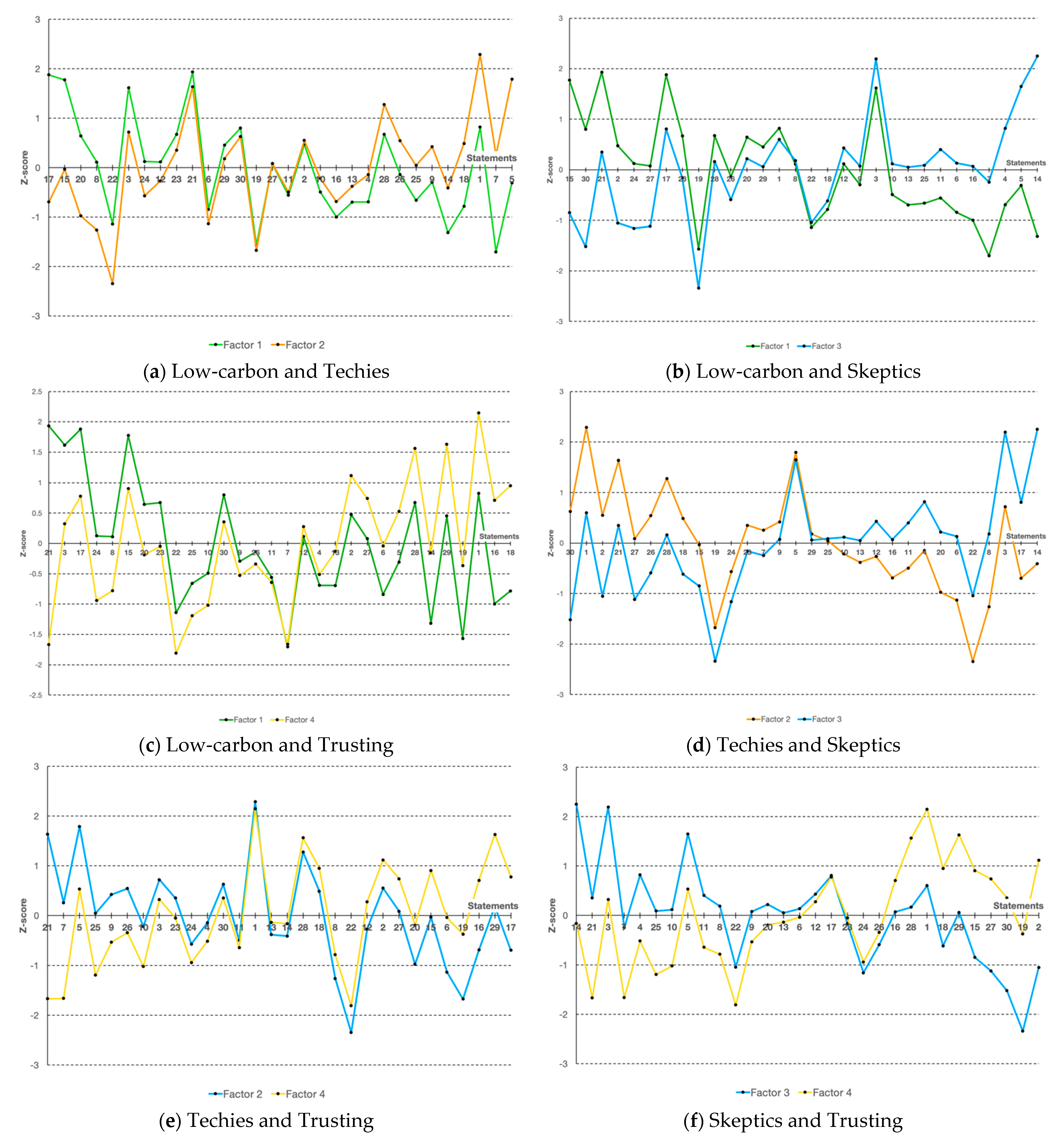
References
- Kappagantu, R.; Daniel, S.A.; Suresh, N.S. Techno-Economic Analysis of Smart Grid Pilot Project-Puducherry. Resour. Effic. Technol. 2016, 2, 185–198. [Google Scholar] [CrossRef]
- IEA. World Energy Balances: Overview; IEA: Paris, France, 2020. [Google Scholar]
- European Union. Directive EU 2018/2001, on the Promotion of the Use of Energy from Renewable Sources (Recast); Official Journal of the European Union; European Union: Brussels, Belgium, 2008. [Google Scholar]
- European Union. Directive EU 2018/2002, Amending Directive 2012/27/EU on Energy Efficiency; Official Journal of the European Union; European Union: Brussels, Belgium, 2008. [Google Scholar]
- Ministerio para la Transición Ecológica y el Reto Demográfico. Plan Nacional Integrado De Energía Y Clima (PNIEC) 2021–2030; Ministerio para la Transición Ecológica y el Reto Demográfico: Madrid, Spain, 2020. [Google Scholar]
- Ramos-Real, F.J.; Ramírez-Díaz, A.; Marrero, G.A.; Perez, Y. Willingness to Pay for Electric Vehicles in Island Regions: The Case of Tenerife (Canary Islands). Renew. Sustain. Energy Rev. 2018, 98, 140–149. [Google Scholar] [CrossRef]
- Ramos-Real, F.J.; Barrera-Santana, J.; Ramírez-Díaz, A.; Perez, Y. Interconnecting Isolated Electrical Systems. the Case of Canary Islands. Energy Strategy Rev. 2018, 22, 37–46. [Google Scholar] [CrossRef]
- PECAN. Plan Energético De Canarias (PECAN). 2006. Available online: http://www.datosdelanzarote.com/Uploads/doc/Plan-energ%C3%A9tico-de-Canarias-(PECAN)-2006--20120203134728558pecan.pdf (accessed on 18 June 2021).
- EECan25. EECan25 Estrategia Energética De Canarias 2015–2025. 2017. Available online: http://www.datosdelanzarote.com/Uploads/doc/Estrategia-Energ%C3%A9tica-de-Canarias-2015-2025--2018050912053194EECan25_DocumentoPreliminar_junio2017-(1).pdf (accessed on 18 June 2021).
- EXCELTUR. Estudio Del Impacto Económico Del Turismo Sobre La Economía Y El Empleo De Las Islas Canarias; Alianza para la Excelencia Turística (EXCELTUR): Madrid, Spain, 2018. [Google Scholar]
- World Tourism Organization. Climate Change and Tourism Responding to Global Challenges; World Tourism Organization: Madrid, Spain, 2008. [Google Scholar]
- Tsai, K.; Lin, T.; Hwang, R.; Huang, Y. Carbon Dioxide Emissions Generated by Energy Consumption of Hotels and Homestay Facilities in Taiwan. Tour. Manag. 2014, 42, 13–21. [Google Scholar] [CrossRef]
- Jarvis, D.S.L.; Sovacool, B.K. Conceptualizing and Evaluating Best Practices in Electricity and Water Regulatory Governance. Energy 2011, 36, 4340–4352. [Google Scholar] [CrossRef]
- Nocera, F.; Giuffrida, S.; Trovato, M.R.; Gagliano, A. Energy and New Economic Approach for nearly Zero Energy Hotels. Entropy 2019, 21, 639. [Google Scholar] [CrossRef]
- Zografakis, N.; Gillas, K.; Pollaki, A.; Profylienou, M.; Bounialetou, F.; Tsagarakis, K.P. Assessment of Practices and Technologies of Energy Saving and Renewable Energy Sources in Hotels in Crete. Renew. Energy 2011, 36, 1323–1328. [Google Scholar] [CrossRef]
- Beccali, M.; Finocchiaro, P.; Ippolito, M.G.; Leone, G.; Panno, D.; Zizzo, G. Analysis of some Renewable Energy Uses and Demand Side Measures for Hotels on Small Mediterranean Islands: A Case Study. Energy 2018, 157, 106–114. [Google Scholar] [CrossRef]
- Díaz Pérez, F.; Díaz Martín, R.; Pérez Trujillo, F.; Díaz, M.; Mouhaffel, A. Consumption and Emissions Analysis in Domestic Hot Water Hotels. Case Study: Canary Islands. Sustainability 2019, 11, 599. [Google Scholar] [CrossRef]
- UNWTO. International Tourism Highlights; UNWTO: Madrid, Spain, 2020. [Google Scholar]
- Instituto Canario de Estadística. Estadística De Movimientos Turísticos En Fronteras De Canarias (FRONTUR-Canarias). 2021. Available online: http://www.gobiernodecanarias.org/istac/estadisticas/sectorservicios/hosteleriayturismo/demanda/E16028B.html (accessed on 18 June 2021).
- Instituto Nacional de Estadística. Estadística De Movimientos Turísticos En Fronteras (FRONTUR); Instituto Nacional de Estadística: Madrid, Spain, 2021. [Google Scholar]
- Instituto Canario de Estadística. Encuestas De Alojamiento Turístico. 2021. Available online: http://www.gobiernodecanarias.org/istac/estadisticas/sectorservicios/hosteleriayturismo/oferta/C00065A.html (accessed on 18 June 2021).
- Instituto Tecnológico Hotelero. Informe Sobre la Contribución de las Energías Renovables al Modelo de Sostenibilidad del Sector Hotelero Español; ITH: Madrid, Spain, 2020. [Google Scholar]
- Ramos-Real, F.J.; López-Martín, L.J.; Marrero Díaz, G.; Afonso Rodríguez, J.A. Proyecto Piloto Sobre La Caracterización De Los Usos Finales De La Energía En Diferentes Tipos De Consumidores En Canarias. Dirección General de Industria y Energía del Gobierno de Canarias en Colaboración con La Fundación Empresa-Universidad de La Laguna. 2009. Available online: https://www.gobiernodecanarias.org/cmsweb/export/sites/energia/doc/eficienciaenergetica/pure/caractusosfinales.pdf (accessed on 18 June 2021).
- Valbuena Alonso, J.A. Anuario Del Sector Eléctrico De Canarias 2019; Consejo de Transición Ecológica, Lucha contra el Cambio Climático y Planificación Territorial del Gobierno de Canarias: Madrid, Spain, 2019. [Google Scholar]
- Cross, R.M. Exploring Attitudes: The Case for Q Methodology. Health Educ. Res. 2004, 20, 206–213. [Google Scholar] [CrossRef]
- Barker, J.H. Q-Methodology: An Alternative Approach to Research in Nurse Education. Nurse Educ. Today 2008, 28, 917–925. [Google Scholar] [CrossRef]
- Byram, J.N.; Organ, J.M.; Yard, M.; Schmalz, N.A. Investigating Student Perceptions of a Dissection-Based Undergraduate Gross Anatomy Course using Q Methodology. Anat. Sci. Educ. 2019, 13, 149–157. [Google Scholar] [CrossRef]
- Woods, C. Exploring Emotion in the Higher Education Workplace. High Educ. 2012, 64, 891–909. [Google Scholar] [CrossRef]
- Logo, E. Q-Method Based Environmental Awareness Measurement in Transportation. Int. J. Traffic Transp. Eng. 2013, 3, 45–53. [Google Scholar] [CrossRef][Green Version]
- Barry, J.; Proops, J. Seeking Sustainability Discourses with Q Methodology. Ecol. Econ. 1999, 28, 337–345. [Google Scholar] [CrossRef]
- D’Amato, D.; Droste, N.; Winkler, K.J.; Toppinen, A. Thinking Green, Circular Or Bio: Eliciting Researchers’ Perspectives on a Sustainable Economy with Q Method. J. Clean. Prod. 2019, 230, 460–476. [Google Scholar] [CrossRef]
- Banks, A.S.; Gregg, P.M. Grouping Political Systems: Q-Factor Analysis of A Cross-Polity Survey. Am. Behav. Sci. 1965, 9, 3–6. [Google Scholar] [CrossRef]
- Ellis, G.; Barry, J.; Robinson, C. Many Ways to Say ‘no’, Different Ways to Say ‘yes’: Applying Q-Methodology to Understand Public Acceptance of Wind Farm Proposals. J. Environ. Plan. Manag. 2007, 50, 517–551. [Google Scholar] [CrossRef]
- Wolsink, M.; Breukers, S. Contrasting the Core Beliefs regarding the Effective Implementation of Wind Power. an International Study of Stakeholder Perspectives. J. Environ. Plan. Manag. 2010, 53, 535–558. [Google Scholar] [CrossRef]
- Beckham Hooff, S.; Botetzagias, I.; Kizos, A. Seeing the Wind (Farm): Applying Q-Methodology to Understand the Public’s Reception of the Visuals Around a Wind Farm Development. Environ. Commun. 2017, 11, 700–722. [Google Scholar] [CrossRef]
- Frate, C.A.; Brannstrom, C.; de Morais, M.V.G.; de Azevedo Caldeira-Pires, A. Procedural and Distributive Justice Inform Subjectivity regarding Wind Power: A Case from Rio Grande do Norte, Brazil. Energy Policy 2019, 132, 185–195. [Google Scholar] [CrossRef]
- Chang, R.; Cao, Y.; Lu, Y.; Shabunko, V. Should BIPV Technologies be Empowered by Innovation Policy Mix to Facilitate Energy Transitions?—Revealing Stakeholders’ Different Perspectives using Q Methodology. Energy Policy 2019, 129, 307–318. [Google Scholar] [CrossRef]
- Naspetti, S.; Mandolesi, S.; Zanoli, R. Using Visual Q Sorting to Determine the Impact of Photovoltaic Applications on the Landscape. Land Use Policy 2016, 57, 564–573. [Google Scholar] [CrossRef]
- Späth, L. Large-Scale Photovoltaics? Yes Please, but Not Like this! Insights on Different Perspectives Underlying the Trade-Off between Land use and Renewable Electricity Development. Energy Policy 2018, 122, 429–437. [Google Scholar] [CrossRef]
- Díaz, P.; van Vliet, O. Drivers and Risks for Renewable Energy Developments in Mountain Regions: A Case of a Pilot Photovoltaic Project in the Swiss Alps. Energy Sustain. Soc. 2018, 8, 1–17. [Google Scholar] [CrossRef]
- Frate, C.A.; Brannstrom, C. Stakeholder Subjectivities regarding Barriers and Drivers to the Introduction of Utility-Scale Solar Photovoltaic Power in Brazil. Energy Policy 2017, 111, 346–352. [Google Scholar] [CrossRef]
- Cuppen, E.; Breukers, S.; Hisschemöller, M.; Bergsma, E. Q Methodology to Select Participants for a Stakeholder Dialogue on Energy Options from Biomass in the Netherlands. Ecol. Econ. 2010, 69, 579–591. [Google Scholar] [CrossRef]
- Cotton, M.; Devine-Wright, P. Discourses of Energy Infrastructure Development: A Q-Method Study of Electricity Transmission Line Siting in the UK. Environ. Plan. A 2011, 43, 942–960. [Google Scholar] [CrossRef]
- Cuppen, E.; Bosch-Rekveldt, M.G.C.; Pikaar, E.; Mehos, D.C. Stakeholder Engagement in Large-Scale Energy Infrastructure Projects: Revealing Perspectives using Q Methodology. Int. J. Proj. Manag. 2016, 34, 1347–1359. [Google Scholar] [CrossRef]
- Pagnussatt, D.; Petrini, M.; dos Santos, A.C.M.Z.; da Silveira, L.M. What do Local Stakeholders Think about the Impacts of Small Hydroelectric Plants? using Q Methodology to Understand Different Perspectives. Energy Policy 2018, 112, 372–380. [Google Scholar] [CrossRef]
- Kougias, I.; Nikitas, A.; Thiel, C.; Szabó, S. Clean Energy and Transport Pathways for Islands: A Stakeholder Analysis using Q Method. Transp. Res. Part D Transp. Environ. 2020, 78, 102180. [Google Scholar] [CrossRef]
- Parkins, J.R.; Hempel, C.; Beckley, T.M.; Stedman, R.C.; Sherren, K. Identifying Energy Discourses in Canada with Q Methodology: Moving Beyond the Environment Versus Economy Debates. Environ. Sociol. 2015, 1, 304–314. [Google Scholar] [CrossRef]
- Matinga, M.N.; Pinedo-Pascua, I.; Vervaeke, J.; Monforti-Ferrario, F.; Szabó, S. Do African and European Energy Stakeholders Agree on Key Energy Drivers in Africa? using Q Methodology to Understand Perceptions on Energy Access Debates. Energy Policy 2014, 69, 154–164. [Google Scholar] [CrossRef]
- Dairon, M.; Parkins, J.R.; Sherren, K. Seeking common ground in contested energy technology landscapes. Insights from a Q-methodology study. In Governing Shale Gas. Development, Citizen Participation and Decision Making in the US, Canada, Australia and Europe; Whitton, J., Cotton, M., Charnley-Parry, I.M., Brasier, K., Eds.; Routledge: London, UK, 2018; pp. 256–271. [Google Scholar]
- Byrne, R.; Byrne, S.; Ryan, R.; O’Regan, B. Applying the Q-Method to Identify Primary Motivation Factors and Barriers to Communities in Achieving Decarbonisation Goals. Energy Policy 2017, 110, 40–50. [Google Scholar] [CrossRef]
- Lee, B. The Fundamentals of Q Methodology. J. Res. Methodol. 2017, 2, 57–95. [Google Scholar] [CrossRef]
- ten Klooster, P.M.; Visser, M.; de Jong, M.D.T. Comparing Two Image Research Instruments: The Q-Sort Method Versus the Likert Attitude Questionnaire. Food Qual. Prefer. 2008, 19, 511–518. [Google Scholar] [CrossRef]
- Ehlert, K.M.; Orr, M.K. Comparing Grouping Results between Cluster Analysis and Q-Methodology. In Proceedings of the 2019 IEEE Frontiers in Education Conference (FIE), Covington, KY, USA, 16–19 October 2019; pp. 1–3. [Google Scholar]
- Stenner, P.; Stainton Rogers, R. Q Methodology and Qualiquantology: The Example of Discriminating between Emotions; Psychology Press: London, UK, 2004. [Google Scholar]
- Deubel, A.R.; Gamboa, E.B. Q Methodology: An Alternative for Participation in the Reform of Higher Education Policy in Columbia. Cienc. Política 2014, 9, 237–264. [Google Scholar]
- Brown, S.R. A Primer on Q Methodology. Operant. Subj. 1993, 16, 91–138. [Google Scholar]
- Rieber, L. Building a Software Tool to Explore Subjectivity in the Classroom: A Design Case. Int. J. Des. Learn. 2020, 11, 140–150. [Google Scholar] [CrossRef]
- Yaremko, R.M.; Harari, H.; Harrison, R.C.; Lynn, E. Handbook of Research and Quantitative Methods in Psychology: For Students and Professionals; Psychology Press: London, UK, 1986. [Google Scholar]
- Gorush, R.L. Factor Analysis, 2nd ed.; Erlbaum: Hillsdale, NJ, USA, 1983. [Google Scholar]
- Zeller, R.A. Measurement Error, Issues and Solutions, in Encyclopedia of Social Measurement, 1st ed.; Elsevier: Oxford, UK, 2005. [Google Scholar]
- Kaiser, H.F. The Application of Electronic Computers to Factor Analysis. Educ. Psychol. Meas. 1960, 20, 141–151. [Google Scholar] [CrossRef]
- Cattell, R.B. The Scree Test for the Number of Factors. Multivar. Behav. Res. 1966, 1, 245–276. [Google Scholar] [CrossRef] [PubMed]
- Hair, J.F.; Black, W.C.; Babin, B.J.; Anderson, R.E. Multivariate Data Analysis, 7th ed.; Prentice Hall: Upper Saddle River, NJ, USA, 2010. [Google Scholar]
- Westad, F.; Hersletha, M.; Lea, P.; Martens, H. Variable Selection in PCA in Sensory Descriptive and Consumer Data. Food Qual. Prefer. 2003, 14, 463. [Google Scholar] [CrossRef]
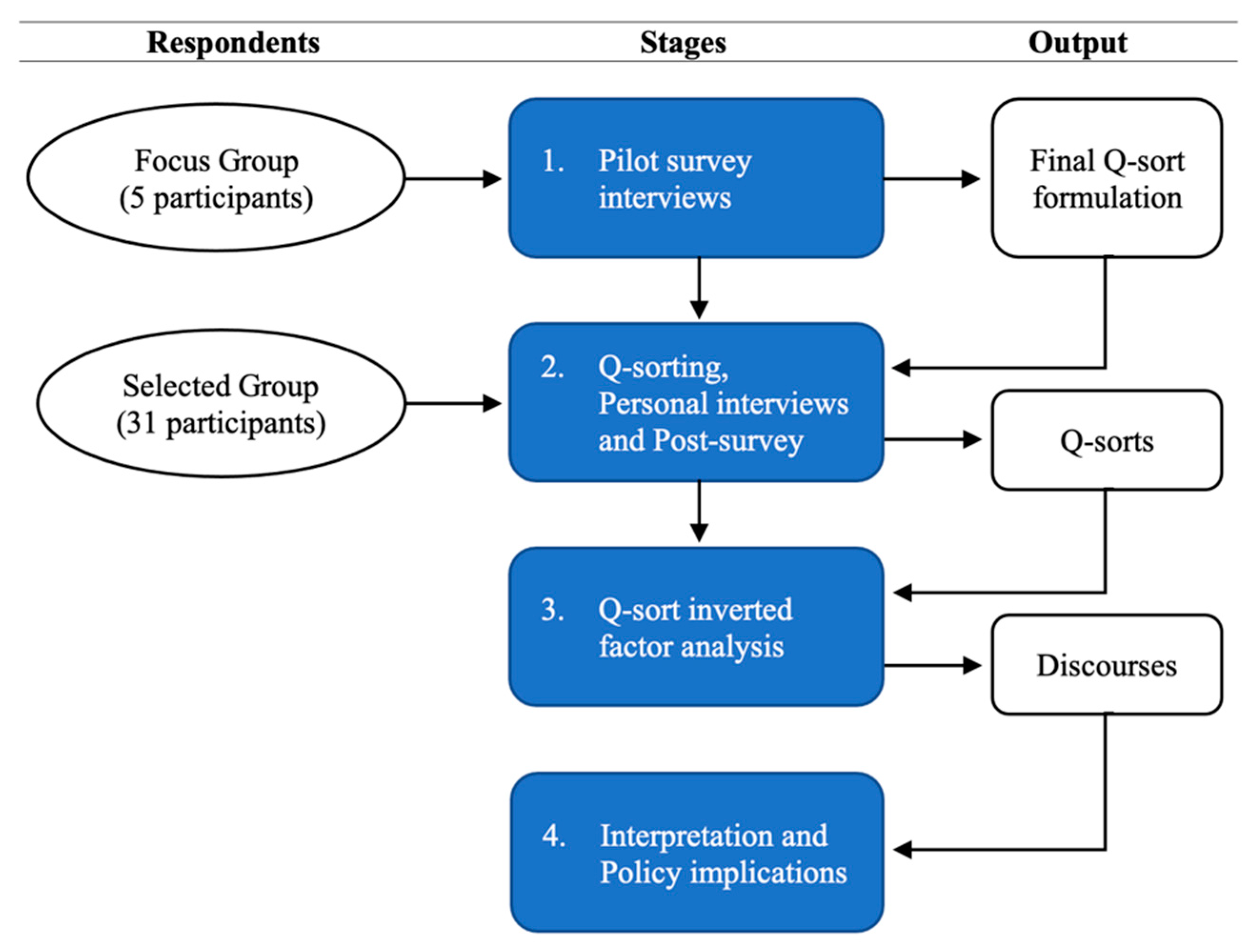
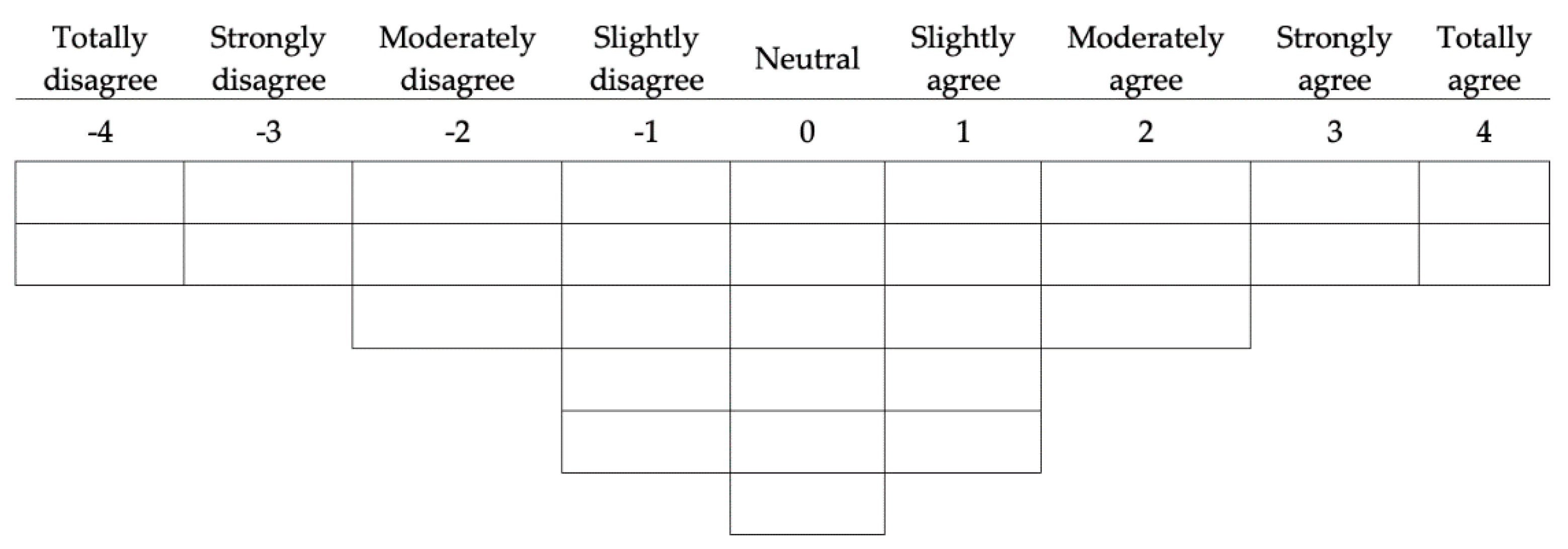
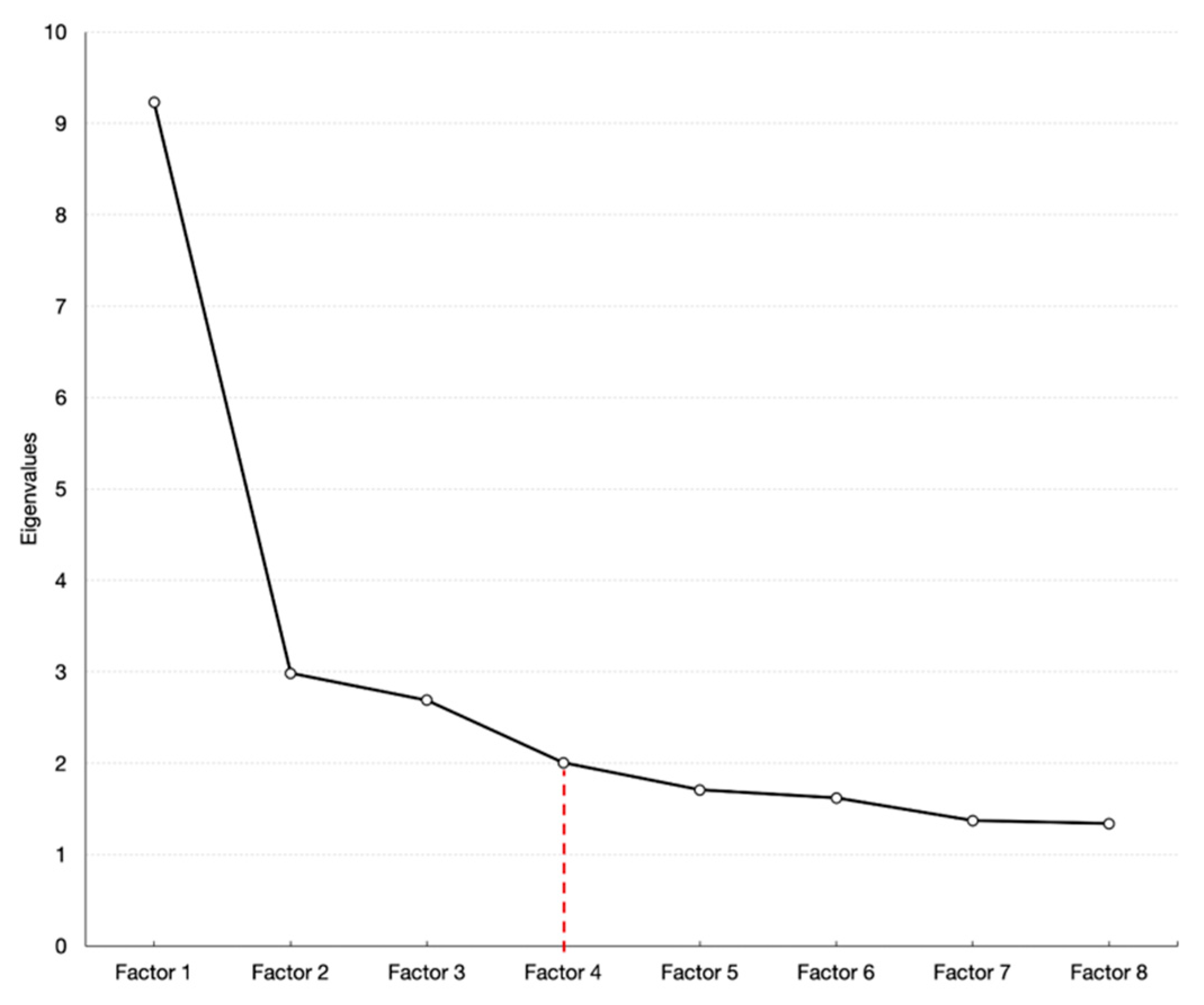

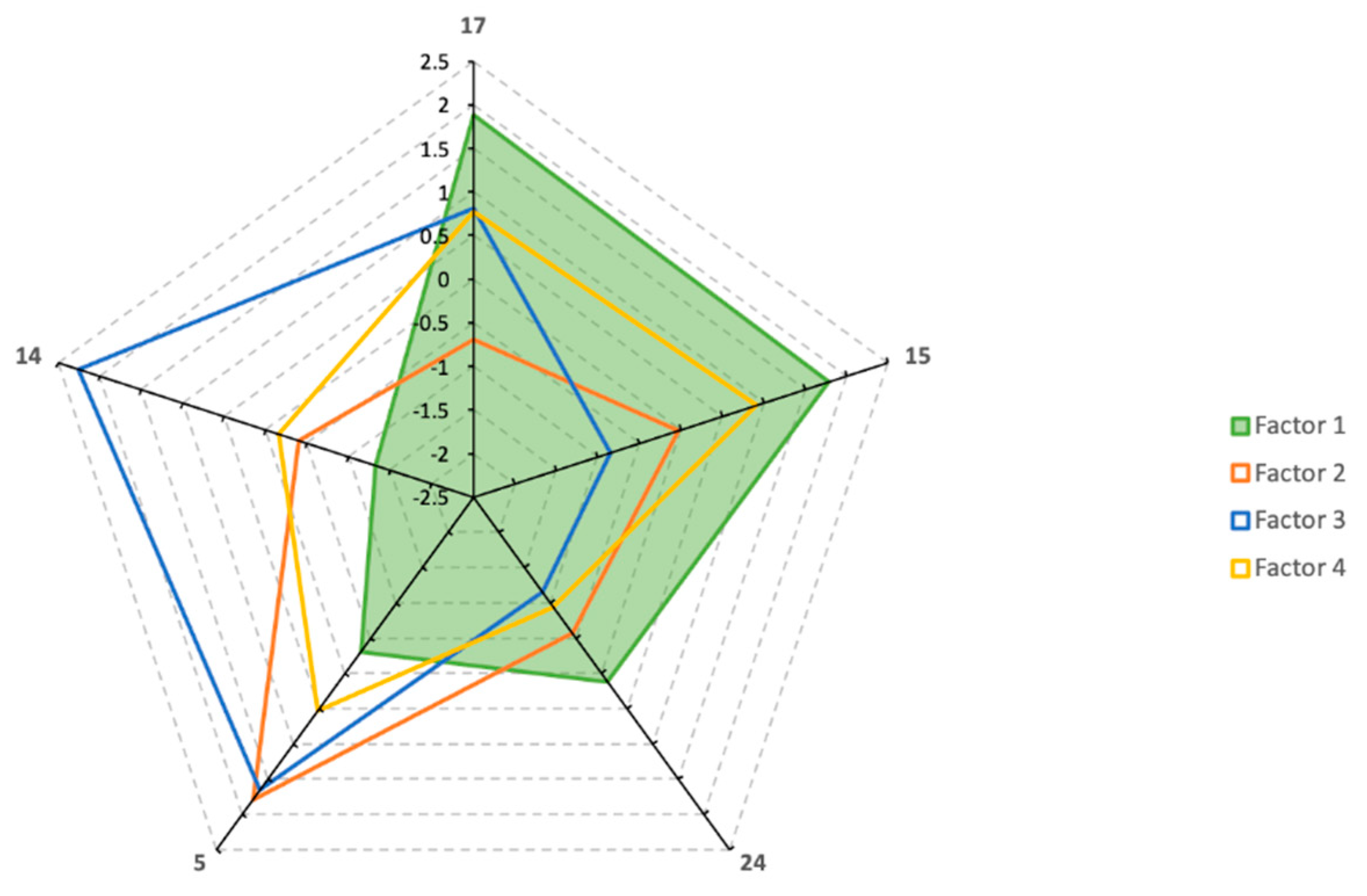

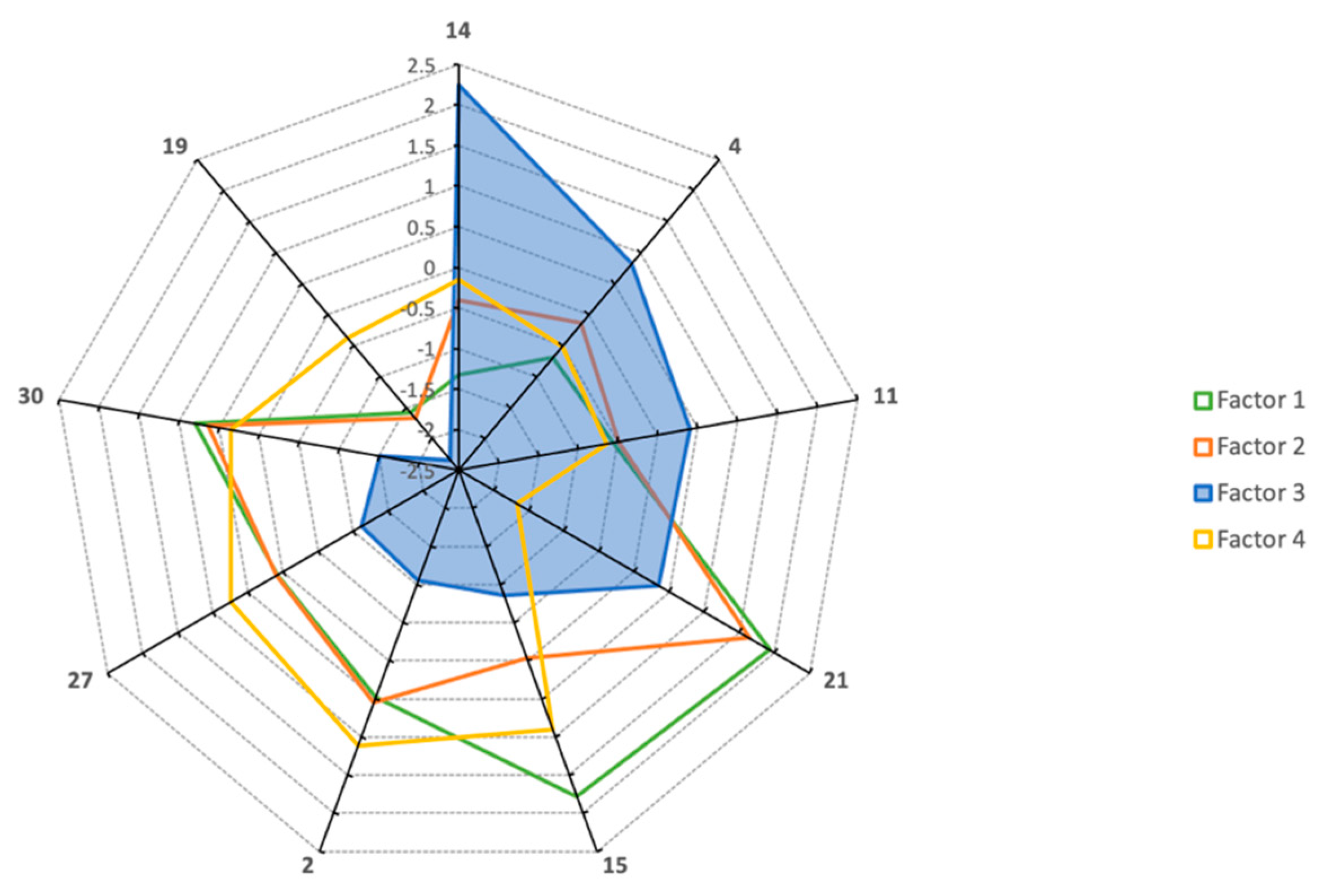

| No. | Statement 1 |
|---|---|
| BLOCK 1: General measures, taxation, and awareness | |
| 1 | In order to improve energy consumption management, the installation of self-consumption energy systems using renewable energies, together with demand management and storage systems, is a priority. |
| 2 | The hotel sector is very proactive in adopting energy efficiency measures. |
| 3 | Regulatory requirements and bureaucratic difficulties hinder the installation of infrastructures for self-consumption of electricity produced from renewable energies. |
| 4 | Private hotel investment in energy transition projects is NOT supported by tax deductions that favor returns on these large investments. |
| 5 | High-tech R&D projects developing new applications or energy flow management systems applicable to the hotel industry should be prioritized. |
| 6 | Bonuses and subsidies for energy efficiency and renewable energy usage projects are sufficient and reach all stakeholders in the tourism sector. |
| 7 | “Green” taxes (eco-taxes) should be imposed on tourists in order to raise funds for the decarbonization of the islands. |
| 8 | “Green” certificates awarded to hotels for using clean electricity and for their efficient use of energy are a decisive factor in customers’ choices when booking a hotel. |
| 9 | Green-room apps (which inform customers about their energy-efficient usage) fail to change customers’ behavior despite the benefits they offer. |
| 10 | Informative energy-saving campaigns that aim to raise awareness among tourists fail to change their behavior. |
| 11 | The European “Next-Generation” funds dedicated to boosting the green economy in the post–COVID-19 era will be sufficient to support the investment projects presented by the tourism/hotel industry. |
| 12 | In the post–COVID-19 reality, projects to decarbonize the hotel sector will be delayed because public spending and investment in other sectors is a priority. |
| 13 | New post–COVID-19 tourists will be more aware of the environmental impacts of their energy behavior in hotel establishments. |
| BLOCK 2: Saving measures in air conditioning and sanitary hot water | |
| 14 | In the short term, it is essential to replace the use of diesel with natural gas/Liquified Petroleum Gas (LPG) in the hotel sector. |
| 15 | Short-term reductions in air conditioning and sanitary hot water consumption will be achieved by replacing thermal equipment and using petroleum derivatives with heat pumps. |
| 16 | In the short term, it is a priority to boost the use of propane-air (LPG-air) to reduce energy consumption in hotels. |
| 17 | Aerothermal heating systems (with several heat pumps) are the best option for replacing diesel boilers in the medium term. |
| 18 | Cogeneration from renewable sources is the best solution for medium-term energy savings. |
| 19 | Residual biomass boilers (pellets, olive bone, etc.) are a reasonable medium-term solution to reduce energy consumption in hotels. |
| 20 | In the medium term, it is a priority to use low-enthalpy (low-temperature) geothermal energy for sanitary hot water production. |
| 21 | The installation of photovoltaic power panels is the best medium-term solution for reducing energy consumption in hotels. |
| BLOCK 3: Energy efficiency measures | |
| 22 | Efficient climate construction does NOT generate significant energy savings. |
| 23 | Air conditioning savings can be achieved by using sensors (smart meters) that disconnect air conditioning or heating when they detect that windows are opened to prevent power wasting. |
| 24 | The use of presence or occupancy detectors for lighting savings is widespread in all hotel establishments. |
| 25 | Outdoor lighting systems (facades, gardens, etc.) must use photovoltaic panels. |
| 26 | Intelligent water leak detection sensors are essential in cases of older, unrenovated hotels. |
| 27 | The installation of showers with flow reducers, thermostats, and timed flow taps is a priority for the reduction of sanitary hot water use. |
| 28 | In order to optimize medium-term energy consumption, it is a priority to install energy management systems for the building (Building Management Systems (BMS)/Environmental Monitoring Systems (EMS)) for better control and to obtain information for decision-making. |
| 29 | It is a priority to reduce the thermal losses of the entire installation through adequate insulation and maintenance. |
| 30 | Hotels must install charging points for electric vehicles. |
| Id | Category Group | Id | Category Group |
|---|---|---|---|
| Energy sector | Other groups of interest | ||
| 8 | Energy supply companies | 3 | Public administrations and political offices |
| 12 | Energy supply companies | 13 | Public administrations and political offices |
| 14 | Energy supply companies | 15 | Public administrations and political offices |
| 23 * | Energy supply companies | 21 | Public administrations and political offices |
| 27 | Energy supply companies | 22 | Public administrations and political offices |
| 30 | Energy supply companies | 5 | NGOs |
| 9 | Technical enterprises and sector consultancy firms | 6 * | NGOs |
| 18 | Technical enterprises and sector consultancy firms | 7 | NGOs |
| 24 * | Technical enterprises and sector consultancy firms | 1 | University academics |
| 28 * | Technical enterprises and sector consultancy firms | 2 | University academics |
| 19 | Energy associations | 4 * | University academics |
| 20 | Energy associations | 29 * | University academics |
| Hotel industry | |||
| 16 | Hotel maintenance technicians | ||
| 26 | Hotel maintenance technicians | ||
| 11 | Hotel managers | ||
| 25 | Hotel managers | ||
| 31 | Hotel managers | ||
| 10 | Hotel associations | ||
| 17 | Hotel associations |
| Category Group | Participant | Factor 1 | Factor 2 | Factor 3 | Factor 4 |
|---|---|---|---|---|---|
| Energy supply companies | 14 | 0.8500 | 0.0273 | 0.1531 | 0.1434 |
| Public administrations and political offices | 13 | 0.7584 | 0.0607 | 0.0740 | 0.2641 |
| Energy supply companies | 8 | 0.7529 | 0.1150 | −0.0331 | 0.3672 |
| Energy associations | 19 | 0.7013 | −0.0295 | 0.0175 | −0.3454 |
| Energy supply companies | 12 | 0.6207 | 0.2605 | 0.3454 | −0.0084 |
| Energy associations | 20 | 0.5906 | 0.4377 | 0.0712 | −0.0704 |
| Public administrations and political offices | 22 | 0.5259 | 0.4745 | 0.1374 | 0.1726 |
| Hotel maintenance technicians | 16 | 0.4114 | 0.2113 | −0.0142 | 0.3089 |
| University academics | 2 | 0.1737 | 0.7279 | −0.2141 | 0.1846 |
| NGOs | 7 | −0.0571 | 0.7145 | 0.0670 | 0.1115 |
| Public administrations and political offices | 21 | 0.0968 | 0.6892 | 0.2590 | 0.4292 |
| University academics | 1 | 0.1799 | 0.6569 | 0.0505 | −0.0189 |
| Technical enterprises and sector consultancy firms | 18 | 0.1446 | 0.6322 | 0.2603 | −0.1453 |
| Hotel maintenance technicians | 26 | 0.4757 | 0.6258 | 0.1296 | 0.1867 |
| Public administrations and political offices | 3 | 0.0294 | 0.5590 | 0.0712 | 0.4351 |
| NGOs | 5 | 0.3602 | 0.5578 | 0.1186 | 0.2494 |
| Hotel managers | 25 | 0.2402 | 0.4971 | 0.2009 | 0.2508 |
| Hotel managers | 11 | −0.1559 | 0.2449 | 0.7859 | −0.2713 |
| Technical enterprises and sector consultancy firms | 9 | 0.0283 | 0.0535 | 0.7527 | 0.1598 |
| Energy supply companies | 30 | 0.2131 | 0.0284 | 0.5344 | 0.1866 |
| Hotel managers | 31 | 0.2615 | 0.2932 | 0.4909 | 0.0818 |
| Hotel associations | 17 | 0.2738 | 0.0136 | 0.1653 | 0.7086 |
| Public administrations and political offices | 15 | 0.2034 | 0.1421 | −0.0081 | 0.6944 |
| Energy supply companies | 27 | −0.1037 | 0.0740 | 0.1579 | 0.6574 |
| Hotel associations | 10 | 0.2620 | 0.2416 | −0.0842 | 0.4848 |
| Explained variance (%) | 17 | 17 | 9 | 11 | |
| No. of defining variables | 8 | 9 | 4 | 4 | |
| Average relative coefficients | 0.8 | 0.8 | 0.8 | 0.8 | |
| Composite reliability | 0.970 | 0.973 | 0.941 | 0.941 | |
| S.E. of factor Z-scores | 0.173 | 0.164 | 0.243 | 0.243 |
| Factor 1 | Factor 2 | Factor 3 | Factor 4 | Factor 5 | Factor 6 | Factor 7 | Factor 8 | |
|---|---|---|---|---|---|---|---|---|
| Eigenvalues | 9.2316 | 2.9839 | 2.6881 | 2.0039 | 1.7078 | 1.6176 | 1.3707 | 1.3376 |
| % explained variance | 30 | 10 | 9 | 6 | 6 | 5 | 4 | 4 |
| Cumulative % explained variance | 30 | 40 | 49 | 55 | 61 | 66 | 70 | 74 |
| Factor 1 | Factor 2 | Factor 3 | Factor 4 | |
|---|---|---|---|---|
| (Low-carbon) | (Techies) | (Skeptics) | (Trusting) | |
| Factor 1 (Low-carbon) | 1 | 0.4326 | 0.1464 | 0.3746 |
| Factor 2 (Techies) | 0.4326 | 1 | 0.3046 | 0.425 |
| Factor 3 (Skeptics) | 0.1464 | 0.3046 | 1 | 0.0861 |
| Factor 4 (Trusting) | 0.3746 | 0.425 | 0.0861 | 1 |
| No. | Statement | Q-Value | Z-Score |
|---|---|---|---|
| 17 | Aerothermal heating systems (with several heat pumps) are the best option for replacing diesel boilers in the medium term. | 4 | 1.88 |
| 15 | Short-term reductions in air conditioning and sanitary hot water consumption will be achieved by replacing thermal equipment and using petroleum derivatives with heat pumps. | 3 | 1.78 |
| 24 | The use of presence or occupancy detectors for lighting savings is widespread in all hotel establishments. | 1 | 0.12 |
| 5 | High-tech R&D projects developing new applications or energy flow management systems applicable to the hotel industry should be prioritized. | 0 | −0.31 |
| 14 | In the short term, it is essential to replace the use of diesel with natural gas/LPG in the hotel sector. | −3 | −1.32 |
| No. | Statement | Q-Value | Z-Score |
|---|---|---|---|
| 26 | Intelligent water leak detection sensors are essential in cases of older, unrenovated hotels. | 1 | 0.54 |
| 15 | Short-term reduction in air conditioning and sanitary hot water consumption will be achieved by replacing thermal equipment and using petroleum derivatives with heat pumps. | 0 | −0.03 |
| 17 | Aerothermal heating systems (with several heat pumps) are the best option for replacing diesel boilers in the medium term. | −2 | −0.69 |
| 20 | In the medium term, it is a priority to use low-enthalpy (low temperature) geothermal energy for sanitary hot water production. | −2 | −0.98 |
| No. | Statement | Q-Value | Z-Score |
|---|---|---|---|
| 14 | In the short term, it is essential to replace the use of diesel with natural gas/LPG in the hotel sector. | 4 | 2.25 |
| 4 | Private hotel investment in energy transition projects is NOT supported by tax deductions that favor the returns on these large investments. | 3 | 0.82 |
| 11 | The European “Next-Generation” funds dedicated to boosting the green economy in the post-COVID-19 era will be sufficient to support the investment projects presented by the tourism/hotel industry. | 1 | 0.4 |
| 21 | The installation of photovoltaic power panels is the best medium-term solution for reducing energy consumption in hotels. | 1 | 0.35 |
| 15 | Short-term reduction in air conditioning and sanitary hot water consumption will be achieved by replacing thermal equipment and using petroleum derivatives with heat pumps. | −2 | −0.85 |
| 2 | The hotel sector is very proactive in adopting energy efficiency measures. | −2 | −1.05 |
| 27 | The installation of showers with flow reducers, thermostats, and timed flow taps is a priority for the reduction of sanitary hot water use. | −3 | −1.12 |
| 30 | Hotels must install charging points for electric vehicles. | −4 | −1.52 |
| 19 | Residual biomass boilers (pellets, olive bone, etc.) are a reasonable medium-term solution to reduce energy consumption in hotels. | −4 | −2.34 |
| No. | Statement | Q-Value | Z-Score |
|---|---|---|---|
| 29 | It is a priority to reduce the thermal losses of the entire installation through adequate insulation and maintenance. | 4 | 1.63 |
| 15 | Short-term reductions in air conditioning and sanitary hot water consumption will be achieved by replacing thermal equipment and using petroleum derivatives with heat pumps. | 2 | 0.9 |
| 27 | The installation of showers with flow reducers, thermostats, and timed flow taps is a priority for the reduction of sanitary hot water use. | 1 | 0.74 |
| 5 | High-tech R&D projects developing new applications or energy flow management systems applicable to the hotel industry should be prioritized. | 1 | 0.53 |
| 19 | Residual biomass boilers (pellets, olive bone, etc.) are a reasonable medium-term solution to reduce energy consumption in hotels. | −1 | −0.37 |
| 21 | The installation of photovoltaic power panels is the best medium-term solution for reducing energy consumption in hotels. | −4 | −1.67 |
| Z-Score | |||||
|---|---|---|---|---|---|
| No. | Statement | Factor 1 | Factor 2 | Factor 3 | Factor 4 |
| 12 | In the post-COVID-19 reality, projects to decarbonize the hotel sector will be delayed because public spending and investment in other sectors is a priority. | 0.116 | −0.27 | 0.43 | 0.277 |
| 13 | New post-COVID-19 tourist will be more aware of the environmental impacts of their energy behavior in hotel establishments. | −0.7 | −0.38 | 0.05 | −0.133 |
| Respondent Group | Low-Carbon | Techies | Skeptics | Trusting | Total |
|---|---|---|---|---|---|
| Energy sector | |||||
| Energy supply companies | 3 | 1 | 1 | 5 | |
| Technical enterprises and sector consultancy firms | 1 | 1 | 2 | ||
| Energy associations | 2 | 2 | |||
| Hotel industry | |||||
| Hotel maintenance technicians | 1 | 1 | 2 | ||
| Hotel managers | 1 | 2 | 3 | ||
| Hotel associations | 2 | 2 | |||
| Other groups of interest | |||||
| Public administrations and political offices | 2 | 2 | 1 | 5 | |
| NGOs | 2 | 2 | |||
| University academics | 2 | 2 | |||
| Total | 8 | 9 | 4 | 4 |
| No. | Statements | Low-Carbon | Techies | Skeptics | Trusting |
|---|---|---|---|---|---|
| 1 | In order to improve energy consumption management, the installation of self-consumption energy systems using renewable energies, together with demand management and storage systems, is a priority. | 2 | 4 | 2 | 4 |
| 2 | The hotel sector is very proactive in adopting energy efficiency measures. | 1 | 2 | −2 | 3 |
| 3 | Regulatory requirements and bureaucratic difficulties hinder the installation of infrastructures for self-consumption of electricity produced from renewable energies. | 3 | 2 | 4 | 1 |
| 5 | High-tech R&D projects developing new applications or energy flow management systems applicable to the hotel industry should be prioritized. | 0 | 4 | 3 | 1 |
| 6 | Bonuses and subsidies for energy efficiency and renewable energy usage projects are sufficient and reach all stakeholders in the tourism sector. | −2 | −3 | 0 | 0 |
| 7 | “Green” taxes (eco-taxes) should be imposed on tourists in order to raise funds for the decarbonization of the islands. | −4 | 1 | −1 | −3 |
| 8 | “Green” certificates awarded to hotels for using clean electricity and for their efficient use of energy are a decisive factor in customers’ choice when booking a hotel. | 0 | −3 | 1 | −2 |
| 10 | Informative energy-saving campaigns that aim to raise awareness among tourists fail to change their behavior. | −1 | 0 | 0 | −2 |
| Statements | Measures Proposed |
|---|---|
| 1 | Self-consumption using renewable energies together with storage systems should be the priority strategic objective of the energy transitions of hotels in the Canary Islands. |
| 2 | Energy efficiency measures should also be a priority strategic objective, given the sector’s proactivity in adopting them. |
| 3 | Administrative procedures need to be simplified to accelerate the introduction of renewable energy and self-consumption. |
| 5 | High-tech R&D projects should be publicly promoted and co-financed, as they generate high value-adding activities and quality employment. |
| 6 | Bonuses and subsidies need to be reassessed by performing a case-specific analysis and prioritizing those that generate the most emissions savings. |
| 7 | Green taxes should not be imposed on tourists, as they are not supported by the vast majority of the sector. |
| 8, 10 | The conditions in which these types of campaigns are more successful should be analyzed from the point of view of both consumers’ preferences and the services that the hotel can offer. |
| No. | Statements | Low-Carbon | Techies | Skeptics | Trusting |
|---|---|---|---|---|---|
| 14 | In the short term, it is essential to replace the use of diesel with natural gas/LPG in the hotel sector. | −3 | −1 | 4 | 0 |
| 15 | Short-term reduction in air conditioning and sanitary hot water consumption will be achieved by replacing thermal equipment, using petroleum derivatives with heat pumps. | 3 | 0 | −2 | 2 |
| 16 | In the short term, it is a priority to boost the use of propane-air (LPG-air) to reduce energy consumption in hotels. | −2 | −2 | 0 | 1 |
| 17 | Aerothermal heating systems (with several heat pumps) are the best option for replacing diesel boilers in the medium term. | 4 | −2 | 2 | 2 |
| 19 | Residual biomass boilers (pellets, olive bone, etc.) are a reasonable medium-term solution to reduce energy consumption in hotels. | −4 | −4 | −4 | −1 |
| 21 | The installation of photovoltaic power panels is the best medium-term solution to reduce energy consumption in hotels. | 4 | 3 | 1 | −4 |
| Statements | Measures Proposed |
|---|---|
| 14, 16 | An information dissemination policy should be established in order to shed light on the feasible energy mix in the transition process. It is also necessary to guarantee what the system of distribution to hotels will be and over what timeframes. |
| 15, 17 | Although heat pumps are an accepted solution, it is necessary to further investigate why some industry representatives and technicians do not agree on their use. |
| 19 | Residual biomass boilers are not a solution for Canary Islands hotels. |
| 21 | Alternatives should be found to ensure that photovoltaic solutions are integrated appropriately into hotel establishments or locations outside hotels (solar farms). |
| No. | Statements | Low-Carbon | Techies | Skeptics | Trusting |
|---|---|---|---|---|---|
| 22 | Efficient climate construction does NOT generate significant energy savings. | −3 | −4 | −2 | −4 |
| 24 | The use of presence or occupancy detectors for lighting savings is widespread in all hotel establishments. | 1 | −1 | −3 | −2 |
| 25 | Outdoor lighting systems (facade, gardens, etc.) must use photovoltaic panels. | −1 | 0 | 0 | −3 |
| 28 | In order to optimize medium-term energy consumption, it is a priority to install energy management systems for the building (BMS-EMS) for better control and obtaining of information for decision-making. | 2 | 3 | 1 | 3 |
| 29 | It is a priority to reduce the thermal losses of the entire installation through adequate insulation and maintenance. | 1 | 0 | 0 | 4 |
| 30 | Hotels must install charging points for electric vehicles. | 2 | 2 | −4 | 1 |
| Statements | Measures Proposed |
|---|---|
| 22 | Keep the regulatory requirements for new constructions up to date in terms of energy efficiency requirements, taking into account the climatology of the islands. |
| 24 | Campaign to make the use of presence/occupancy detection systems more widespread. |
| 25 | Find solutions for outdoor lighting systems using photovoltaic panels that can be integrated appropriately into the facility environment. |
| 28 | Conduct training courses for hotel staff to familiarize them with the use of new technologies such as BMS and EMS tools. |
| 29 | Conduct staff training on maintenance oriented toward energy efficiency. |
| 30 | Funding lines should be established to accelerate the implementation of charging infrastructures for electric vehicles in hotel establishments. |
Publisher’s Note: MDPI stays neutral with regard to jurisdictional claims in published maps and institutional affiliations. |
© 2021 by the authors. Licensee MDPI, Basel, Switzerland. This article is an open access article distributed under the terms and conditions of the Creative Commons Attribution (CC BY) license (https://creativecommons.org/licenses/by/4.0/).
Share and Cite
Lorente de las Casas, A.; Mirkova, I.; Ramos-Real, F.J. Stakeholders’ Perceptions of the Possible Energy Sustainability Solutions in the Hotels of the Canary Islands. Sustainability 2021, 13, 6943. https://doi.org/10.3390/su13126943
Lorente de las Casas A, Mirkova I, Ramos-Real FJ. Stakeholders’ Perceptions of the Possible Energy Sustainability Solutions in the Hotels of the Canary Islands. Sustainability. 2021; 13(12):6943. https://doi.org/10.3390/su13126943
Chicago/Turabian StyleLorente de las Casas, Andrés, Ivelina Mirkova, and Francisco J. Ramos-Real. 2021. "Stakeholders’ Perceptions of the Possible Energy Sustainability Solutions in the Hotels of the Canary Islands" Sustainability 13, no. 12: 6943. https://doi.org/10.3390/su13126943
APA StyleLorente de las Casas, A., Mirkova, I., & Ramos-Real, F. J. (2021). Stakeholders’ Perceptions of the Possible Energy Sustainability Solutions in the Hotels of the Canary Islands. Sustainability, 13(12), 6943. https://doi.org/10.3390/su13126943






